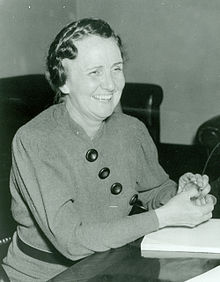Dixie Bibb Graves
Dixie Bibb Graves | |
|---|---|
 | |
| United States Senator from Alabama | |
| In office August 20, 1937 – January 10, 1938 | |
| Preceded by | Hugo Black |
| Succeeded by | Lister Hill |
| First Lady of Alabama | |
| In office January 14, 1935 – January 17, 1939 | |
| Governor | Bibb Graves |
| Preceded by | Margaret Miller |
| Succeeded by | Juliet Dixon |
| In office January 17, 1927 – January 19, 1931 | |
| Governor | Bibb Graves |
| Preceded by | Elizabeth Brandon |
| Succeeded by | Margaret Miller |
| Personal details | |
| Born | July 26, 1882 Montgomery, Alabama, U.S. |
| Died | January 21, 1965 (aged 82) Montgomery, Alabama, U.S. |
| Political party | Democratic |
| Spouse | Bibb Graves |
Dixie Bibb Graves (July 26, 1882 – January 21, 1965) was a First Lady from the state of Alabama, and the first woman United States Senator from Alabama.
Biography
Dixie Bibb was born on July 26, 1882, outside Montgomery, Alabama to Peyton and Isabel Thorpe Bibb on the family plantation. After attending the public schools, in 1900, at the age of 18, she married state legislator and first cousin David Bibb Graves.[1]
Career
Graves became a civic leader. She was a trustee of Alabama Boys’ Industrial School in Birmingham and president of the United Daughters of the Confederacy from 1915 to 1917. She was active in the Women’s Christian Temperance Union, the Alabama Federation of Women’s Clubs, and the women’s suffrage movement.[2]
Appointed on August 20, 1937, as a Democrat by her husband, Governor Bibb Graves, to the United States Senate to fill the vacancy caused by the resignation of Hugo L. Black, Graves was the first woman Senator from Alabama, and the first married woman to serve in the Senate (all the others had been widows). She served from August 20, 1937, until her resignation on January 10, 1938.[3] Governor Graves' decision to appoint his wife as interim senator until a special election could be held, was made in order to favor none of the possible candidates over any other. He wanted their continued support for his programs. During her term, she voted in support of New Deal programs directed at agriculture, crop control, and labor policy.
Graves was active in many causes, including public welfare, health, and education. During World War II, she recruited for the Women's Army Corp (WACs), and worked for the Red Cross and the United Service Organizations (USO). One WAC group was designated as the Dixie Bibb Graves Unit. A very active member of the State Advisors on Women's Activities of the National Foundation for Infantile Paralysis, an organization later known as the National March of Dimes Association, she worked for a cure and hospitals to treat polio. She was also chair or honorary chair of the Women's Division of the State Democratic Campaign in 1948, 1952, 1956, and 1960. She was a member of the Alabama Historical Association, the American Legion Auxiliary, the No Name Club, and the United Daughters of the Confederacy.[4]
Death and legacy
Graves died in Montgomery, Montgomery County, Alabama, on January 21, 1965 (age 82 years, 179 days). She is interred at Greenwood Cemetery, Montgomery, Alabama.[5] She was named to the Alabama Women's Hall of Fame in 1972.
References
- ^ "Dixie Bibb Graves". Encyclopedia of Alabama. Retrieved 1 July 2013.
- ^ "Dixie Bibb Graves". Biographical Directory of the United States Congress. Retrieved 1 July 2013.
- ^ "Dixie Bibb Graves". Govtrack US Congress. Retrieved 1 July 2013.
- ^ "Dixie Bibb Graves". Encyclopedia of Alabama. Retrieved 1 July 2013.
- ^ "Dixie Bibb Graves". The Political Graveyard. Retrieved 1 July 2013.
External links
- 1882 births
- 1965 deaths
- Alabama Democrats
- American suffragists
- American temperance activists
- Appointed United States Senators
- Democratic Party United States Senators
- Female United States Senators
- First Ladies and Gentlemen of Alabama
- People from Montgomery, Alabama
- United States Senators from Alabama
- Women in Alabama politics
- 20th-century American politicians

